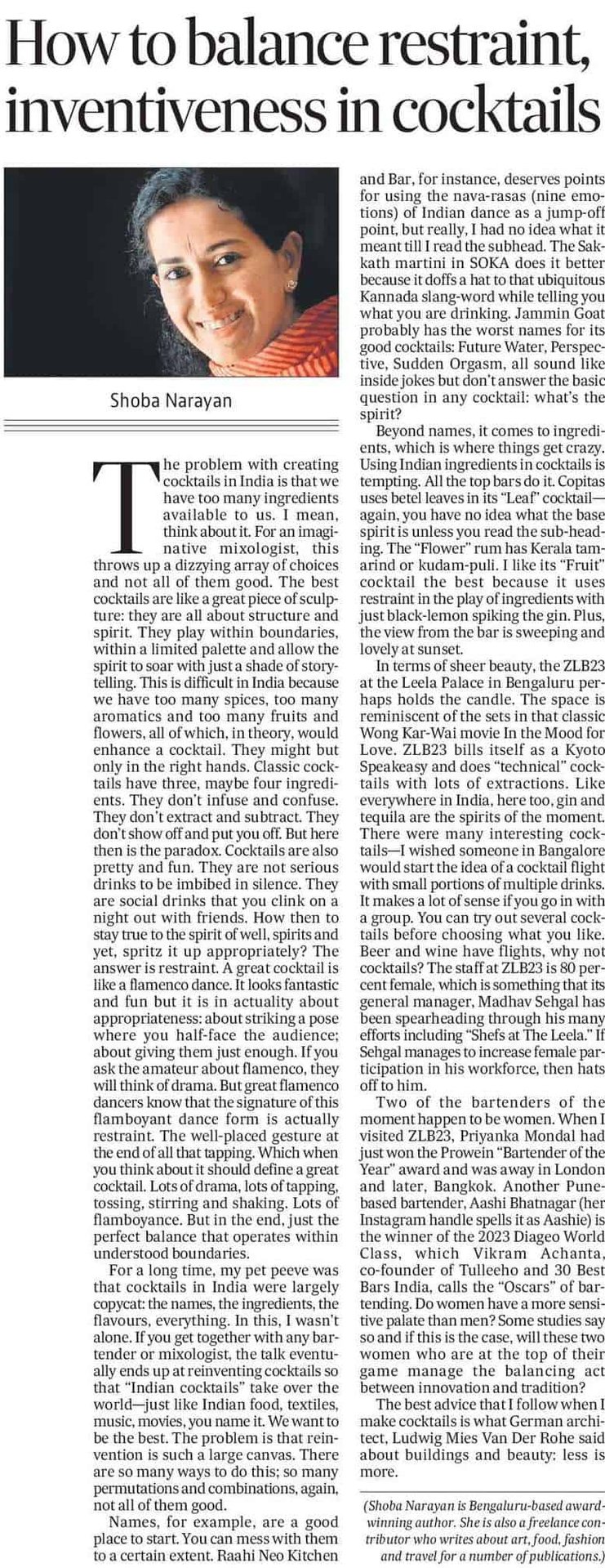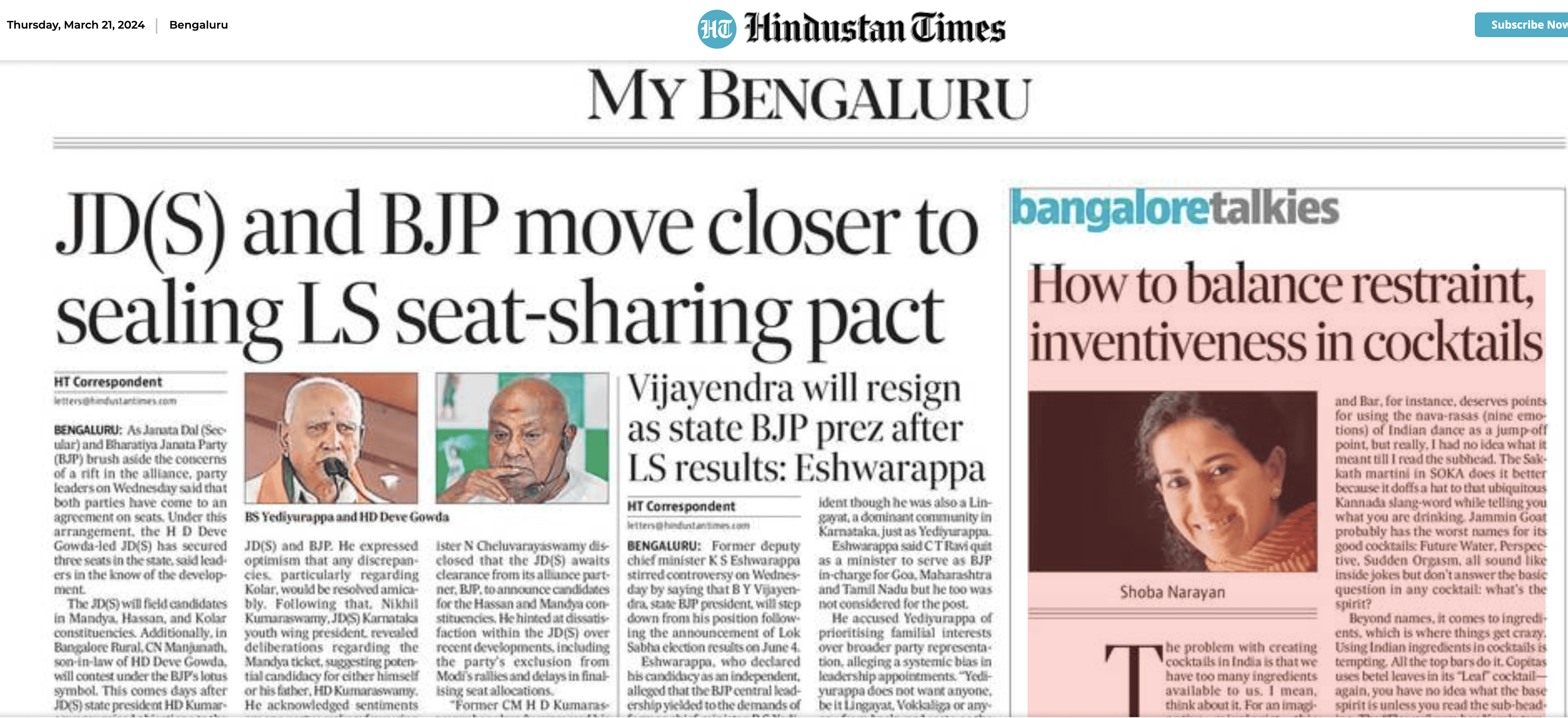The problem with creating cocktails in India is that we have too many ingredients available to us. I mean, think about it. For an imaginative mixologist, this throws up a dizzying array of choices and not all of them good. The best cocktails are like a great piece of sculpture: they are all about structure and spirit. They play within boundaries, within a limited palette and allow the spirit to soar with just a shade of storytelling. This is difficult in India because we have too many spices, too many aromatics and too many fruits and flowers, all of which, in theory, would enhance a cocktail. They might but only in the right hands.
Classic cocktails have three, maybe four ingredients. They don’t infuse and confuse. They don’t extract and subtract. They don’t show off and put you off. But here then is the paradox. Cocktails are also pretty and fun. They are not serious drinks to be imbibed in silence. They are social drinks that you clink on a night out with friends. How then to stay true to the spirit of well, spirits and yet, spritz it up appropriately? The answer is restraint.
A great cocktail is like a flamenco dance. It looks fantastic and fun but it is in actuality about appropriateness: about striking a pose where you half-face the audience; about giving them just enough. If you ask the amateur about flamenco, they will think of drama. But great flamenco dancers know that the signature of this flamboyant dance form is actually restraint. The well-placed gesture at the end of all that tapping. Which way you think about it should define a great cocktail. Lots of drama, lots of tapping, tossing, stirring and shaking. Lots of flamboyance. But in the end, just the perfect balance that operates within understood boundaries.
For a long time, my pet peeve was that cocktails in India were largely copycat: the names, the ingredients, the flavours, everything. In this, I wasn’t alone. If you get together with any bartender or mixologist, the talk eventually ends up at reinventing cocktails so that “Indian cocktails” take over the world—just like Indian food, textiles, music, movies, you name it. We want to be the best. The problem is that reinvention is such a large canvas. There are so many ways to do this; so many permutations and combinations, again, not all of them good.
Names, for example, are a good place to start. You can mess with them to a certain extent. Raahi Neo Kitchen and Bar, for instance, deserves points for using the nava-rasas (nine emotions) of Indian dance as a jump-off point, but really, I had no idea what it meant till I read the subhead. The Sakkath martini in SOKA does it better because it doffs a hat to that ubiquitous Kannada slang-word while telling you what you are drinking. Jammin Goat probably has the worst names for its good cocktails: Future Water, Perspective, Sudden Orgasm, all sound like inside jokes but don’t answer the basic question in any cocktail: what’s the spirit?
Beyond names, it comes to ingredients, which is where things get crazy. Using Indian ingredients in cocktails is tempting. All the top bars do it. Copitas uses betel leaves in its “Leaf” cocktail—again, you have no idea what the base spirit is unless you read the sub-heading. The “Flower” rum has Kerala tamarind or kudam-puli. I like its “Fruit” cocktail the best because it uses restraint in the play of ingredients with just black-lemon spiking the gin. Plus, the view from the bar is sweeping and lovely at sunset.
In terms of sheer beauty, the ZLB23 at the Leela Palace in Bengaluru perhaps holds the candle. The space is reminiscent of the sets in that classic Wong Kar-Wai movie In the Mood for Love. ZLB23 bills itself as a Kyoto Speakeasy and does “technical” cocktails with lots of extractions. Like everywhere in India, here too, gin and tequila are the spirits of the moment. There were many interesting cocktails—I wished someone in Bangalore would start the idea of a cocktail flight with small portions of multiple drinks. It makes a lot of sense if you go in with a group. You can try out several cocktails before choosing what you like. Beer and wine have flights, why not cocktails? The staff at ZLB23 is 80 percent female, which is something that its general manager, Madhav Sehgal has been spearheading through his many efforts including “Shefs at The Leela.” If Sehgal manages to increase female participation in his workforce, then hats off to him.
Two of the bartenders of the moment happen to be women. When I visited ZLB23, Priyanka Mondal had just won the Prowein “Bartender of the Year” award and was away in London and later, Bangkok. Another Pune-based bartender, Aashi Bhatnagar (her Instagram handle spells it as Aashie) is the winner of the 2023 Diageo World Class, which Vikram Achanta, co-founder of Tulleeho and 30 Best Bars India, calls the “Oscars” of bartending. Do women have a more sensitive palate than men? Some studies say so and if this is the case, will these two women who are at the top of their game manage the balancing act between innovation and tradition?
The best advice that I follow when I make cocktails is what German architect, Ludwig Mies Van Der Rohe said about buildings and beauty: less is more.
Shoba Narayan is Bangalore-based award-winning author. She is also a freelance contributor who writes about art, food, fashion and travel for a number of publications.



-k4lD-U204025897261YmH-250x250%40HT-Web.jpg)




Leave A Comment